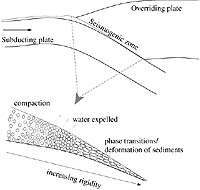![[Currents headergraphic]](../../images/currents_header.gif)
August 2, 1999
Earthquake analysis sheds new light on the nature of destructive earthquakes
By Tim Stephens
The world's largest earthquakes occur in subduction zones, where one plate of the
earth's crust dives down below another plate. A new analysis by UCSC researchers
of subduction zone earthquakes indicates that key properties of the fault zones change
systematically with depth, resulting in very different types of earthquakes depending
on the depth at which the fault ruptures.
 |
| Generalized diagram of a subduction zone, with an expanded-scale view of the seismogenic
zone at the interface between the two plates of the earth's crust (Larger
illustration). |
The new findings represent a significant advance in understanding some of the most
destructive types of earthquakes, including those that cause tsunamis, said professor
of earth sciences Thorne Lay. Lay and graduate student Susan Bilek conducted the
study and published their findings in the July 29 issue of the scientific journal
Nature.
Bilek and Lay analyzed the records of hundreds of earthquakes that occurred along
subduction zones in Japan, Alaska, Mexico, Central America, Peru, and Chile. These
are all locations where an oceanic plate is sliding under a continental plate, generating
earthquakes along the interface between the two plates. The researchers found that
the rigidity of the rock and sediments in the area of contact between the two plates
increased steadily with depth in all six subduction zones.
"Rigidity plays a role in determining the amount and duration of shaking that
occurs in an earthquake," Bilek said. The rigidity of the material where a fault
ruptures affects both the duration of the rupture and the speed of the resulting
seismic waves, she explained.
Bilek found that earthquakes in subduction zones vary from shallow events that rupture
slowly to faster ruptures at greater depths. This is particularly important in light
of previous observations by other researchers indicating that large tsunamis may
be generated by shallow earthquakes with abnormally long rupture durations. Some
tsunamis occur when an earthquake generates a submarine landslide, but that mechanism
can be ruled out in many cases. The new results support the hypothesis that tsunami-causing
earthquakes occur in regions of low rigidity at shallow depths, Bilek said.
In addition, according to Lay, the results suggest that tsunami earthquakes can occur
in many more places than previously expected, because the properties that characterize
them were found in all of the subduction zones studied.
"The consistency between the different subduction zones surprised us,"
Lay said. "The relationship between rigidity and depth appears to be a common
attribute of subduction zones in regions with otherwise very different characteristics."
The recognition of this systematic variation provides a powerful tool for seismologists,
Lay said. By incorporating an analysis of rigidity variations into their models of
earthquake mechanisms, seimologists may improve the accuracy of their earthquake
probability calculations, he noted.
The mechanism behind the systematic increase in rigidity with depth is uncertain,
but one possibility is the effect of increasing pressure on sediments carried down
into the subduction zone beneath the overriding plate, Bilek said. As pressure and
temperature increase with depth beneath the surface, sediments become compacted,
water is squeezed out, and minerals undergo major alterations, all of which can increase
the rigidity of the subducted materials.
Other factors may also be involved, such as a systematic change in the way stress
is released through the rupture process at increasing depths, Lay said. "It
is even possible that the actual frictional mechanics of earthquakes change with
depth, perhaps as a function of the amount of water present, but this is more speculative,"
Lay said.
To the Currents home page
To UCSC's home page
![[Currents headergraphic]](../../images/currents_header.gif)
![[Currents headergraphic]](../../images/currents_header.gif)
